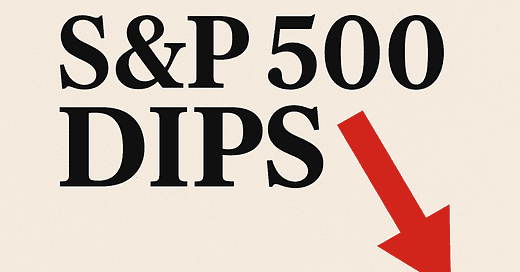Market Recap
The S&P 500 fell 0.8% on Monday as weaker-than-expected retail sales and escalating geopolitical risks pressured investor sentiment.
The Dow Jones lost 260 points, and the Nasdaq dropped nearly 1%.
Oil prices surged over 4% on supply fears, boosting energy stocks but hurting inflation-sensitive sectors.
The VIX volatility index climbed to 19.9, reflecting heightened institutional anxiety.
What’s Behind the Pullback?
May retail sales fell 0.9%, worse than the -0.6% consensus, marking the third consecutive monthly miss and signaling cracks in consumer resilience despite a strong labor market.
Core retail sales (excluding autos) also declined, pressuring major retailers like Home Depot, Target, and Lowe’s, which saw share prices slide on concerns about lower foot traffic and tighter discretionary spending.
Geopolitical Overhang: Trump vs. Tehran
Tensions between Iran and Israel escalated after a weekend exchange of drone and missile fire, with former President Trump demanding Iran’s “unconditional surrender,” raising fears of deeper U.S. involvement.
Oil markets reacted swiftly, pushing WTI crude above $84 per barrel, raising the specter of global supply chain disruptions and renewed inflation pressures just as markets had hoped for Fed rate cuts.
💬 What the Experts Are Saying
Caroline Simmons, CIO at UBS UK:
“What we’re witnessing is a perfect storm. Sticky inflation, weak consumption, and geopolitical flashpoints don’t mix well for risk assets.”Jared Bernstein, Barclays:
“The bond market is calling the Fed’s bluff. Unless inflation drops meaningfully, we may not get any cuts at all this year.”Brad Bechtel, Jefferies:
“The Middle East headlines are more than noise — this could impact global oil flows and shift investor positioning quickly.”Jim Reid, Deutsche Bank:
“Typically, the S&P 500 declines about 6% within three weeks following a geopolitical shock, but then rallies back within another three weeks. Unless we see significant escalation, the impact may be contained.”Pe Giels, BNP Paribas Fortis:
“Markets are justified in not pricing in a major escalation unless the U.S. gets involved or the Strait of Hormuz is blocked. But the risk premium remains elevated.”UBS Global CIO Team:
“We still think the bull market is intact and stocks can continue to move higher over the coming year, but the near-term risk-reward for U.S. stocks looks more balanced now that markets are higher than April levels.”Morningstar Analysts:
“There is minimal margin of safety at current valuations; heightened volatility is expected in the coming quarters, and we’d prefer to see a greater discount to fair value before getting more aggressive.”
What to Watch This Week
Fed Policy Meeting:
The Fed’s two-day meeting begins today; a rate hold is expected, but forward guidance will be crucial.Flash PMIs (Thursday):
Early readings on June’s business activity in services and manufacturing will be closely watched.Oil Inventories & Treasury Auctions:
Data may reflect how markets are hedging amid volatility.
Strategic Recommendations
Shift toward quality: Favor large-cap defensive stocks and companies with pricing power.
Stay liquid: Raise cash allocations to deploy if markets correct further.
Hedge selectively: Use gold, oil ETFs, and short-duration Treasuries for portfolio protection.
Avoid consumer cyclicals: Remain underweight in retail and travel until confidence and sales rebound.
Watch the Fed closely: Hawkish guidance could push markets lower, while a dovish surprise may spark a relief rally.
Outlook: Choppy Waters Ahead
Volatility is expected to remain elevated through the rest of Q2. Fundamentals are intact for many companies, but margin pressures, rate uncertainty, and headline risk from the Middle East favor caution over exuberance. If tensions escalate or the Fed pivots to a hawkish stance, a 5–10% correction in the S&P 500 is plausible. However, in the absence of a crisis, this environment may offer buying opportunities for high-quality names trading at a discount





